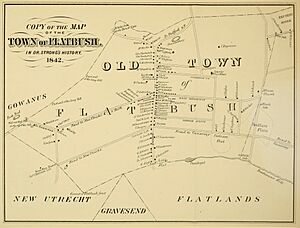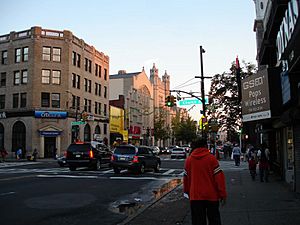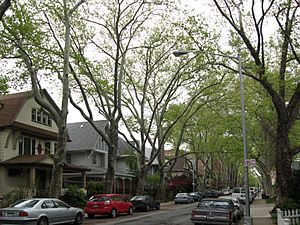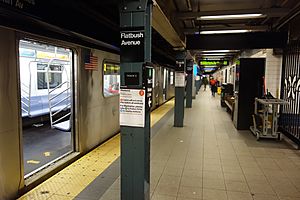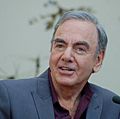Flatbush facts for kids
Quick facts for kids
Flatbush
|
|
|---|---|
|
Neighborhood of Brooklyn
|
|
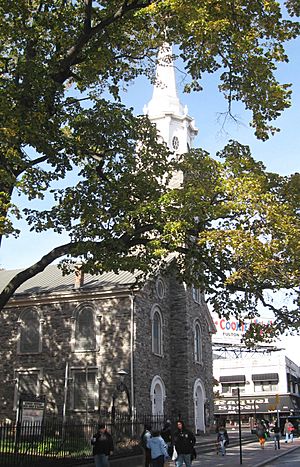
Reformed Protestant Dutch Church of Flatbush, founded in 1654
|
|
| Country | |
| State | |
| City | New York City |
| Borough | Brooklyn |
| Community District | Brooklyn 14 |
| Founded | 1651 |
| Founded by | Dutch colonists |
| Area | |
| • Total | 1.02 sq mi (2.64 km2) |
| Population | |
| • Total | 105,804 |
| • Density | 103,800/sq mi (40,080/km2) |
| Time zone | UTC−5 (Eastern) |
| • Summer (DST) | UTC−4 (EDT) |
| ZIP Code |
11226
|
| Area code | 718, 347, 929, and 917 |
Flatbush is a lively neighborhood in the New York City borough of Brooklyn. It's located in central Brooklyn. You can find Prospect Park to its north, East Flatbush to the east, Midwood to the south, and Kensington and Parkville to the west. This area is also home to important places like Brooklyn College.
Long ago, the Canarsee people lived here before Europeans arrived. Many of their old paths became the main roads we use today. Flatbush started as a Dutch town called Midwout, or Vlachte Bos, in 1651. It was one of the first six European towns on Long Island. For a long time, it stayed a Dutch farming area.
In the late 1800s, trains and roads connected Flatbush to other parts of New York. This made it a popular suburb. In 1898, it became part of the City of Greater New York. The New York City Subway helped it connect even more in the early 1900s. After World War II, many new people moved to Flatbush. They came from the Caribbean, Asia, and other places. Today, Flatbush continues to change with new people moving in and new developments.
Flatbush is part of Brooklyn Community District 14. The New York City Police Department's 67th and 70th Precincts keep the area safe.
Contents
A Journey Through Flatbush History
Early Days: Native Americans and Dutch Settlers
In the 1500s, the Canarsee people lived on western Long Island. They called it Sewanhacka. These tribes moved around to find food. Their trails later became important roads. One of their main villages was near where Flatbush Avenue and Kings Highway meet today.
In 1609, Henry Hudson visited the island. He worked for the Dutch. The Dutch then set up trading posts and towns in their new colony, Nieuw Nederland. They bought land from the Canarsee people. One Dutch town was Midwout, meaning "middle wood." It was founded between 1630 and 1636. It was also known as Vlachte Bos or Flackebos, meaning "wooded plain."
A church was built in 1654. The town had a protective wall. By 1658, it was a center for courts and justice. Early schools also started here in 1659. Important Dutch families, like the Lefferts, built homes here. Their names are still used for streets today.
English Takeover and Changes
In 1664, the English took over New Amsterdam, and the Dutch colony became New York. The towns on Long Island, including Midwout, became part of Kings County in 1683. The English name "Flatbush" slowly replaced the Dutch names.
Even with English rule, Flatbush kept its Dutch feel. Dutch landowners remained in charge, and Dutch was the main language until the late 1700s. Farming was important, and it grew as New York City got bigger.
To help with farm work, many enslaved African people were brought to New York. By 1790, about 41% of Flatbush's population were enslaved people. After the American Revolution (1775–1783), a law in 1799 slowly freed enslaved people born after that date. Slavery was fully ended in New York in 1827.
Becoming a Suburb: The 1800s
Flatbush remained a quiet farming town for a while. The Erie Canal helped farmers grow more produce for the city. A street grid was planned, and Flatbush Avenue became a main road. Irish and German immigrants came to work on farms.
In 1878, the Brooklyn, Flatbush and Coney Island Railway opened. This train connected Flatbush to Coney Island and also to downtown Brooklyn and Manhattan. This was a big step in turning Flatbush into a suburb. Landowners started selling plots for houses instead of farms.
New neighborhoods like Lefferts Manor and Vanderveer Park were built. They offered single-family homes, attracting buyers who wanted a quieter life away from busy Manhattan. Flatbush's population grew quickly before 1900. In 1894, Flatbush officially became part of Brooklyn.
Growth and Change: The 1900s
In the early 1900s, Flatbush grew even faster. The train lines were updated, making it easier to reach Manhattan. Five trolley lines also ran through the area. Ebbets Field, the home of the Brooklyn Dodgers baseball team, was built in northern Flatbush.
After World War I, there was a housing shortage. New laws helped build many new homes and apartments in Flatbush. The neighborhood became home to people from different backgrounds, including Irish Americans, Italian Americans, and American Jews. By 1930, one-third of Flatbush residents were Jewish.
By the Great Depression, Flatbush had a population of 400,000. It had many theaters, schools, churches, and newspapers. Brooklyn College was built in 1935. During World War II, the "soldier from Flatbush" became a symbol of the American soldier.
After the war, Flatbush saw big changes. Older residents moved out, and new groups moved in. In the 1960s, more African Americans and Puerto Ricans came to the area. Later, immigrants from the Caribbean, especially Haitians, also moved to Flatbush. Some buildings became run-down, and crime increased in the 1970s and 80s.
But people in the community worked hard to make things better. Groups like the Flatbush Development Corporation helped fix up buildings. Residents formed groups to protect historic homes and bring businesses back. By the 1990s, Flatbush Avenue's business district was improving.
Flatbush Today: The 2000s
In the 2000s, Flatbush became known for its affordable homes and shops. New residents arrived from Syria, Pakistan, Bangladesh, Russia, and China. The city recognized the diverse cultures by naming areas "Little Caribbean" and "Little Haiti" in 2017 and 2018.
Flatbush continues to grow and change. It faces challenges like traffic and waste, but community groups are working to solve these issues.
Little remains of the original Flatbush village. The 18th-century Lefferts family house was moved to Prospect Park in 1918. Other historic homes like the Wyckoff-Bennett Homestead and the Wyckoff House are still around. The Flatbush Reformed Dutch Church is still at the historic center of Flatbush.
What are the Boundaries of Flatbush?
When Flatbush joined Brooklyn, its old town area became the 29th ward. Today, there are no official borders for the modern neighborhood. Its size is smaller than the old town.
Over time, some areas once part of Flatbush have become their own neighborhoods. These include Prospect Park South, the Beverley Squares, Prospect Lefferts Gardens, Ditmas Park, Fiske Terrace, Victorian Flatbush, and Albemarle-Kenmore Terrace. Flatbush borders Crown Heights to the north, East Flatbush to the east, Kensington and Parkville to the west, and Midwood to the south.
Famous Landmarks in Flatbush
Flatbush has several well-known places. These include Erasmus Hall High School, the Parade Ground, the Flatbush Dutch Reformed Church, and Brooklyn College. The Kings Theatre is a historic building that operated from 1929 to 1977. It reopened in 2015 after being beautifully restored.
Flatbush Population and People
In 2010, Flatbush had 105,804 people living there. The neighborhood is very diverse. In 2010, about 19.9% of residents were White, 48.6% were African American, and 9.2% were Asian. About 19.5% of the population was Hispanic or Latino.
Most people in Flatbush are middle-aged adults and young people. About 25% are under 17, and 29% are between 25 and 44. In 2018, about 22% of residents lived in poverty. Community groups work to help people in need.
Community Support in Flatbush
Flatbush has many groups that help the community. The Flatbush Avenue Business Improvement District (BID) works to keep Flatbush Avenue clean and safe for businesses. They also organize the Flatbush Avenue Street Fair every year. This event celebrates the many cultures in the community.
The Flatbush Development Corporation helps improve the "vitality, diversity, and quality of life" in Flatbush. CAMBA, Inc. is a local nonprofit that offers housing, education, legal help, and healthcare services. Flatbush Cats is a nonprofit that rescues cats and has a large following online.
Police and Fire Services
The NYPD has two precincts that cover Flatbush. The 70th Precinct is in Parkville, and the 67th Precinct is on Snyder Avenue.
The New York City Fire Department (FDNY) has three fire stations in Flatbush:
- Engine Co. 255/Ladder Co. 157 — 1367 Rogers Avenue
- Engine Co. 281/Ladder Co. 147 – 1210 Cortelyou Road
- Engine Co. 248/Battalion 41 – 2900 Snyder Avenue
Getting Around Flatbush
Flatbush is served by the New York City Subway's BMT Brighton Line (B and Q train) and IRT Nostrand Avenue Line (2 and 5 train). The Nostrand Avenue Line ends at the Flatbush Avenue–Brooklyn College station.
Many MTA Regional Bus Operations routes serve the neighborhood, including the B6, B8, B11, B12, B16, B35, B41, B44, B49. Some of these have express versions. There are also express buses like the BM1, BM2, BM3, BM4 that connect Flatbush to other areas.
The main roads in Flatbush are Flatbush Avenue, Nostrand Avenue, and Ocean Avenue, which run north-south. Linden Boulevard, Church Avenue, and Caton Avenue run east-west.
Famous People from Flatbush
Many well-known people have lived in Flatbush, including:
- Neil Diamond (born 1941), a famous singer
- Ruth Bader Ginsburg (1933–2020), a United States Supreme Court Justice
- Bernie Sanders (born 1941), a politician and activist
- Joseph Barbera (1911–2006), an animator who created many cartoons
- Roz Chast (born 1954), a cartoonist for The New Yorker
- Al Davis (1929–2011), owner of the Oakland Raiders football team
- Susan Hayward (1917–1975), an actress
- Leona Helmsley (1920–2007), a businesswoman
- Talib Kweli (born 1975), a rapper
- Joe Paterno (1926-2012), a football coach
- Barbra Streisand (born 1942), a singer and actress
Images for kids
Error: no page names specified (help). In Spanish: Flatbush (Brooklyn) para niños
In Spanish: Flatbush (Brooklyn) para niños


